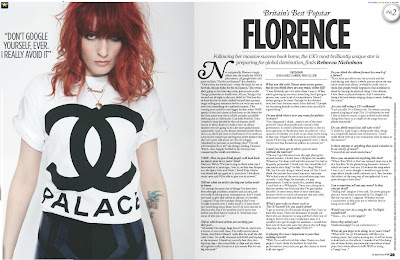By Deanna Hammond-Blackburn and Emma Hall
The contents page DPS contains 8 main images that promote
the different articles. The smallest image is a full shot of Noel Gallagher,
who has his own section as he is the subject of the main image on the front
cover. The image on the contents is small as it has already got a lot of
exposure on the front, as well as a massive 9 page spread in the main magazine.
In both images he is stood with a large amp, but in different poses. On the
contents page, Noel is leaning against the amp in a blue shirt and jeans, very
casually. This represents him as a normal guy; the magazine is focusing on his
musical side rather than his physique. This fits the genre of the magazine, but
breaks more common male representations. The largest image on the contents is a
mid-shot of Adam Ant with a large dog. He is wearing mostly black with some
red, which links to Q’s house style. The representations of this are again more
about his music and personality than his physique, while his masculinity is
being portrayed by being pictured with a large dog.
The contents page is split into sections, with headings
written in the house style, with a white font on a coloured banner. The colours
of the banners are very limited, using only grey, black and red. The page
numbers are all quite small and there is a lot of text for each one, as the
older readership of the magazine is more likely to have the patience to read
through each section than a younger reader would. The page numbers are white in
a red square, which resembles the ‘Q’ logo, while each feature has a red sans
serif title, then black serif writing. This means there is consistency across
the whole page, along with the shared sophisticated white background, and makes
it all connect. The main heading of ‘Content’ is in a simple black font that
would be quite uninteresting, if it weren’t for the cartoon characters
integrated into it, which are linked to an article, explained by a short piece
of anchorage text off of an arrow.
The language used on the contents is a mix of consultative
and casual register, as the reader is likely to be intelligent enough to
understand terms like “rendezvous”, but a s the contents page needs to grab
attention quickly and encourage people to buy it with the magazine’s unique
selling points, the tone needs to also be informal enough to make readers feel
welcome and be invited in. Also, the readers of ‘Q’, predominantly male, tend
to be quite dedicated to the music and so several language signs are used under
the assumption that the readers will understand what they are referencing:
“prancing hermaphrodites and a meat wardrobe, it’s got to be the Lady GaGa
tour”, for example is only understandable if you live in the Western world, and
have been keeping up with gossip about the singer.
The main features have text that cut into the pictures using
a white box that blends seamlessly into the background for a sophisticated
effect. ‘The Q Review’ has its own section off to the right, emphasised with
double lines, a striking red banner and a large photo. There is also a flash to
advertise its improved ‘bigger and better’ section which both emphasises and
justifies this feature’s prominence on the page.
Techniques such as more subtle representations of people,
smaller and more text for a slightly older target audience, a sophisticated and
consistent background with integrated house style and more sophisticated
vocabulary and signs that the readers will be able to identify with, should all
be incorporated into our own magazine.















